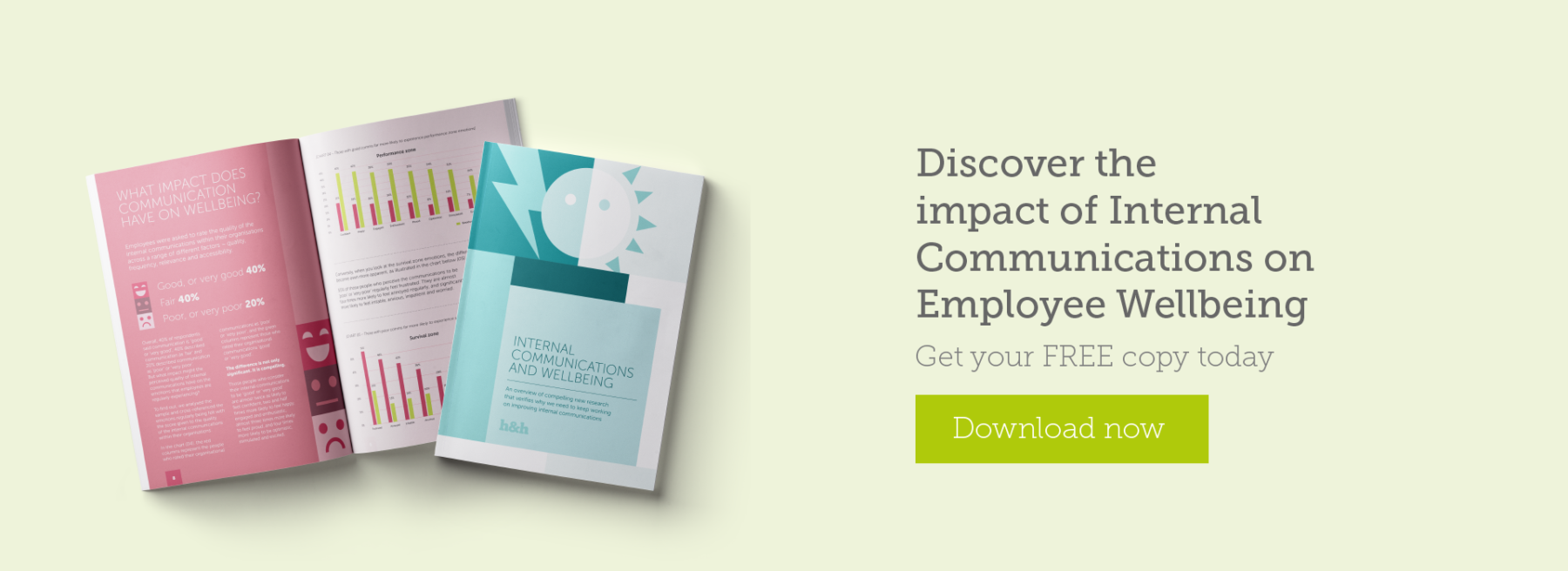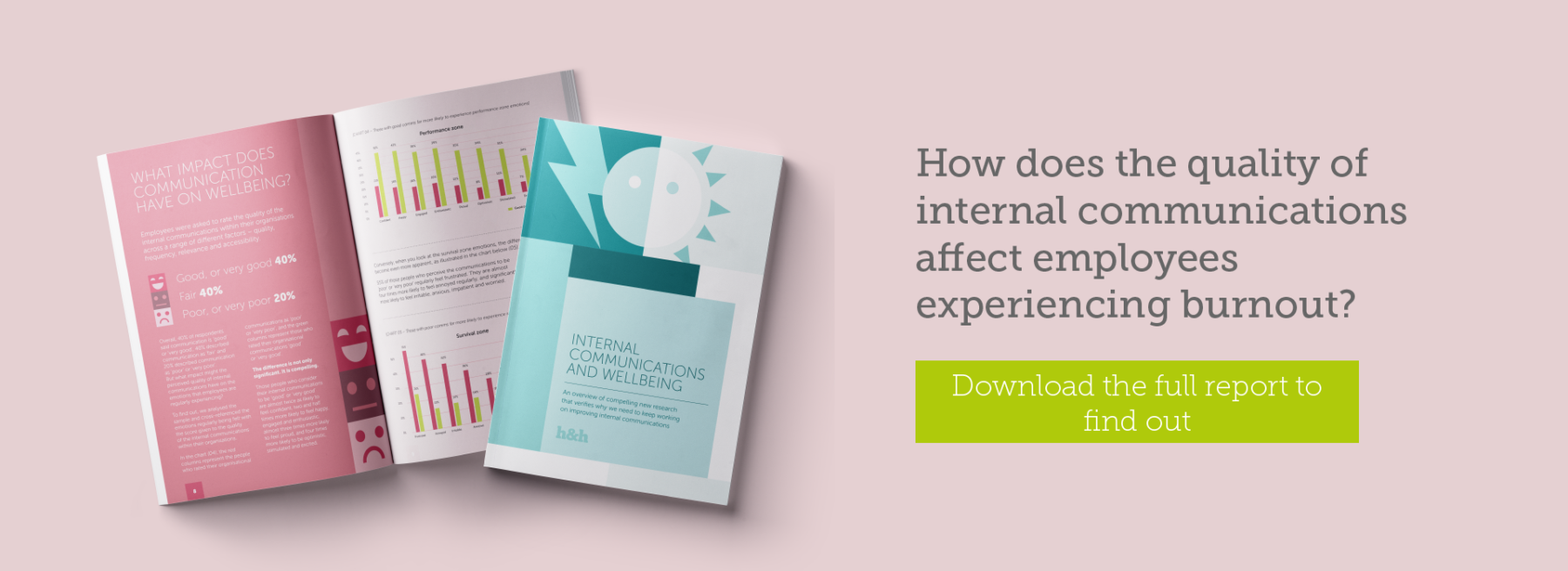Employee Wellbeing: the surprising ways internal communication impacts wellbeing at work
Employee wellbeing is the business buzzword of the decade, and with good reason. If we spend most of our waking hours at work, why shouldn’t we feel good about it?
It’s not just about the feel-good factor though. We already know that employee wellbeing at work plays a vital role in the performance and success of an organisation. And there’s countless health and wellbeing programs out there designed to improve the employee experience.
But these programs are not made equal. It’s important that we focus our efforts on the wellbeing drivers that will make the most impact.
And spoiler alert: it’s not communal pool tables or free sweets in the lunch room. It’s not even more practical initiatives like providing helpful wellbeing resources to employees.
The surprising guest of honour at the round table of employee wellbeing is, in fact, internal communications…
Introducing our employee wellbeing research
At H&H, we commissioned a piece of independent research to explore the connection between employee wellbeing and internal communications.
This research was carried out by Research Now, a highly respected research house. All 528 respondents were based in the UK with a representative sample across gender, age, position and time in the role.

So, what did we find out?
We always expected that the quality of communication in an organisation would have an impact on employee engagement and wellbeing. But even we were surprised at the extent of the impact.
We knew we couldn’t keep these game-changing findings under lock and key. Because the insights they reveal could significantly alter the way we think about employee wellbeing in our organisations.
So in this article, we share some of the key results from our research to help you gain a fresh perspective on the importance of good internal communications within the employee experience.
And while you familiarise yourself with the findings, just consider: are we all doing enough to improve the quality of internal communications for people’s wellbeing at work?
Employee wellbeing: internal communications’ impact on people’s emotions at work
The wellbeing aspects of the research were built around an applied model from the field of positive psychology. The premise of Loehr & Schwartz’ model is that people need to find productive ways to manage their emotional states to ensure they remain healthy and energised over the long term.
The range of emotions that we may experience daily are considered to be either high or low in their intensity, and positive and negative in their impact on our wellbeing. These emotions can be categorised into four quadrants, each representing a specific emotional state.
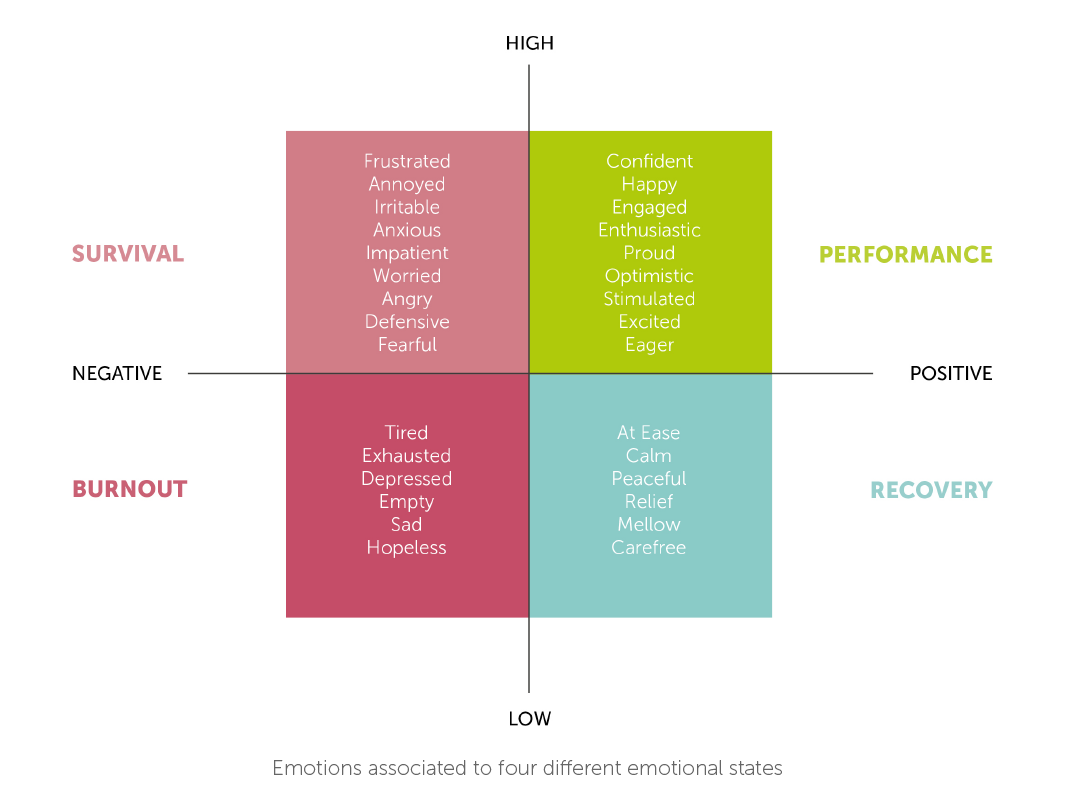
While it might be easy to assume that the best outcome is to spend all of our time in the ‘performance’ zone, these high-intensity emotions are not sustainable over long periods of time.
To keep our wellbeing intact, it’s important to strike a healthy balance between the ‘performance’ and ’recovery’ zones. The most sustainable way to work is to shift in and out of these two zones frequently to balance peak productivity with opportunities to rest and recharge.
But the reality of what’s happening in our organisations tells a very different story.
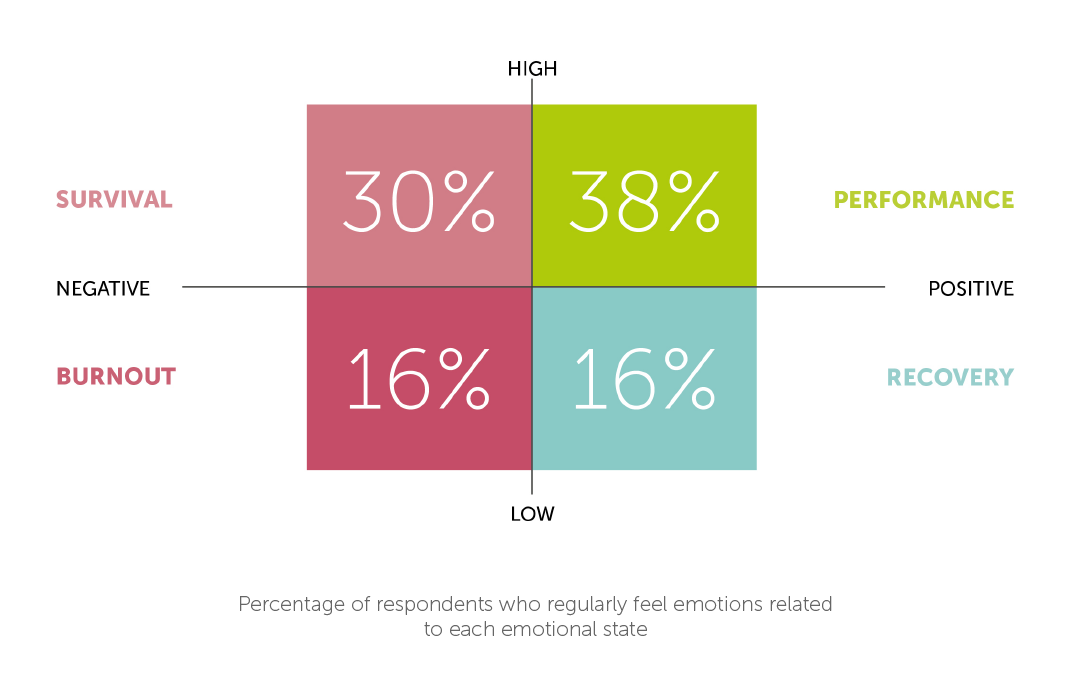
While 38% of the respondents regularly experience performance related emotions, only 16% are regularly in recovery.
And the rest?
In this sample, almost half of the people are feeling emotions associated with the ‘Survival’ and ‘Burn-out’ zones on a regular basis.
If you extrapolate this to the UK employee audience – it would suggest that almost half of employees are regularly experiencing emotional states that are likely to be negatively impacting their state of wellbeing.
You may not be surprised by these results. Previous reports in the UK have found that similar percentages of the workforce grapple with their mental health in ways that correlate with the findings in our research.
But what was surprising, was when we discovered a link between people’s emotional states and the quality of communications within their organisations.
As part of the research, employees were asked to rate the quality, frequency, relevancy and accessibility of their organisation’s internal communications. Their answers were broken down into three categories ranking the respective quality of the organisations’ communications as good, fair, and poor.
We then cross-referenced the emotions employees were regularly feeling with the ‘good’ and ‘poor’ categories.
And the difference is not only significant. It is compelling.
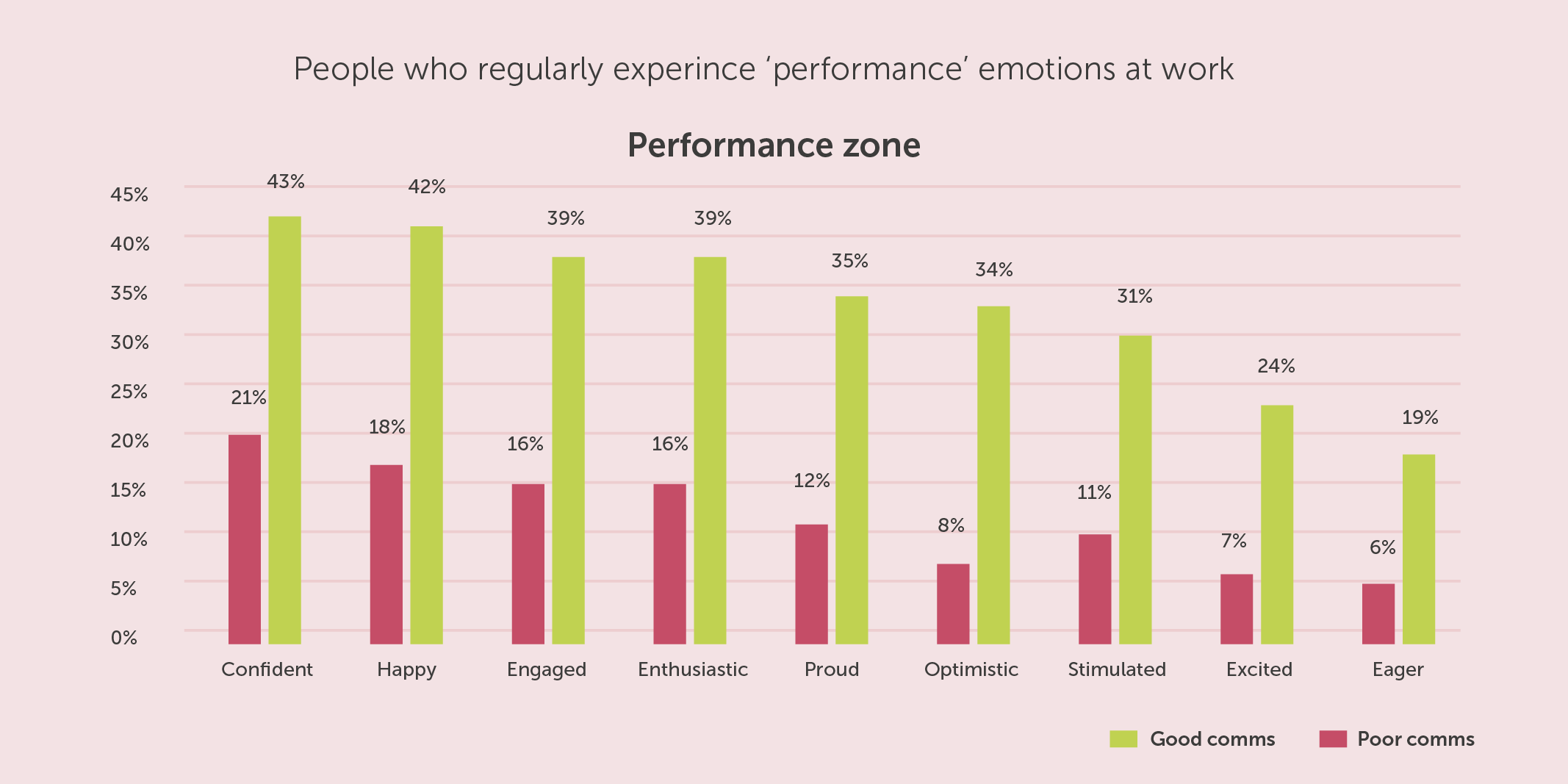

It reveals that people who consider their internal communications to be ‘good’ or ‘very good’ are almost twice as likely to feel confident; two and half times more likely to feel happy, engaged and enthusiastic; almost three times more likely to feel proud; and four times more likely to be optimistic, stimulated and excited.
Conversely, when you look at the ‘survival zone’ emotions – the differences become even more apparent.
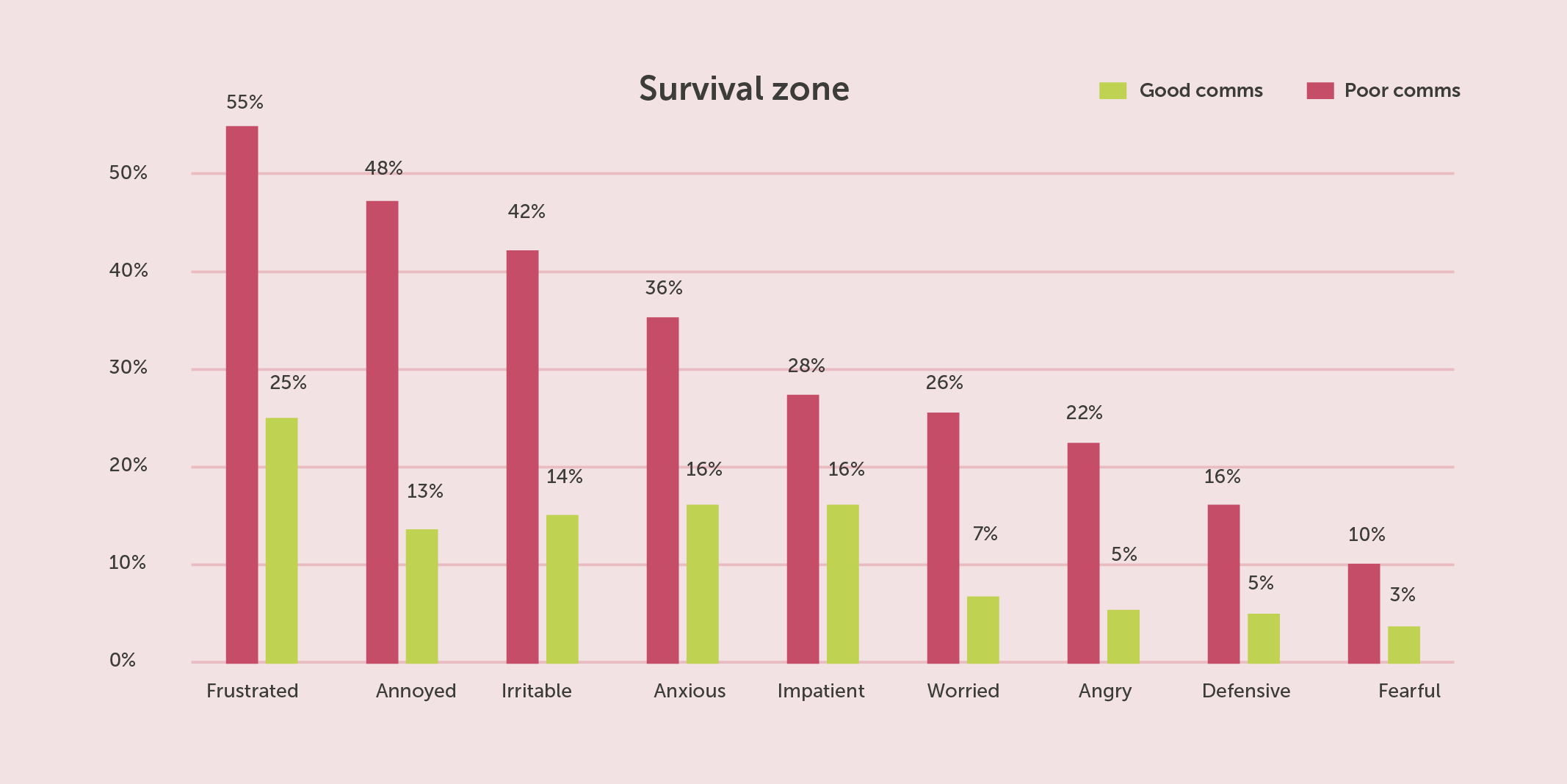

People who perceive their internal communications to be ‘poor’ or ‘very poor’ are almost four times more likely to feel regularly annoyed, and significantly more likely to feel irritable, anxious, impatient and worried.
And of course, the more people experience emotions within the ‘survival’ zone, the more likely it is that they’ll eventually end up experiencing emotions associated with the ‘burn-out’ zone.
The numbers are robust enough to give us confidence that there is a causal link between the quality of internal communication in an organisation, and the effect it has on people’s emotional state.
It suggests that there might be some truth in the notion that the quality of internal communications can affect the health of employees.
The importance of good internal communication to employee wellbeing
The research didn’t stop at employee emotions. We also wanted to see how ‘good internal communications’ fared against other factors in ensuring optimal employee wellbeing.
Respondents were asked to rate how important different factors were to their sense of wellbeing at work.
Salary and bonuses, and job security took the top spots. But because these are considered as core hygiene factors in wellbeing, this wasn’t particularly surprising.
‘Interesting and engaging work’ and ‘being clear on what’s expected of me’ came in at number three and four respectively.
But what ranked at number five? You guessed it – good organisational communication.
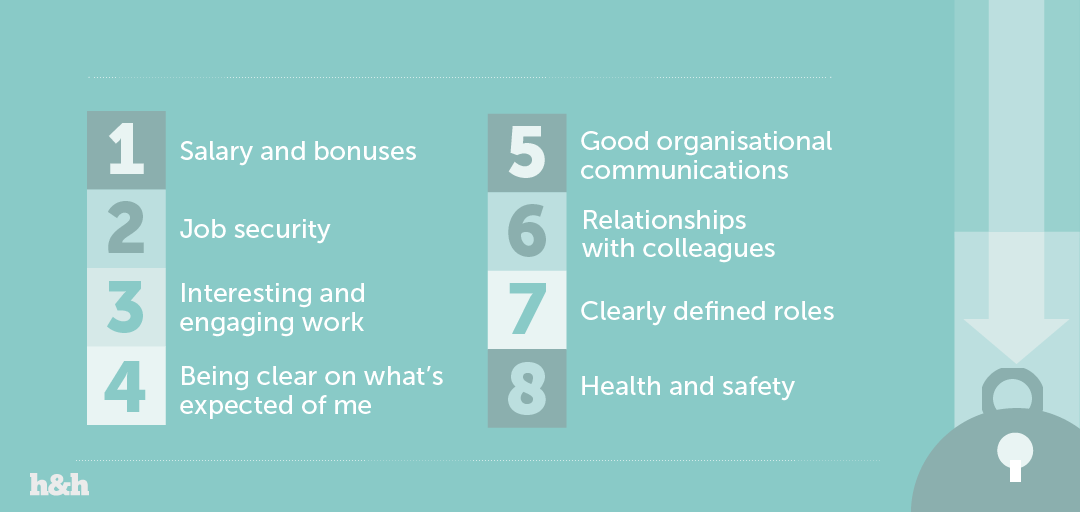

Respondents were asked to rate the importance of various factors to their sense of wellbeing. Good org comms came up as fifth most important.
Of course, we’ve always argued that optimising internal communications should be a top strategic priority in any organisation.
But when you consider that internal communications rarely gets included in a health and wellbeing strategy (we’d love to hear from you if you can prove us wrong!), we think that it’s a pretty significant finding.
Particularly when you consider how highly the respondents ranked it above other, perhaps more expected, engagement factors.
Such as flexible working.
Or the working environment.
Or health and wellbeing services like free gym memberships, and access to private healthcare.
And yet, these benefits and policies seem to attract bigger investments when it comes to improving employee wellbeing.
That’s not to say we shouldn’t be investing in them. After all, these factors all still ranked as important within the research.
But just think how much more focus and attention your organisation invests into wellbeing initiatives like these, when compared to concentrating on maximising the impact of internal communications?
We’d bet a tidy sum that the answer is likely to be a LOT more.
So are we missing an opportunity to make a valuable difference to our people by focusing too much on communicating about wellbeing, instead of communicating effectively for wellbeing?
This report adds to and supports a rapidly growing bank of critical IC and employee engagement research.
It provides further evidence that if we’re seeking happy, productive, healthy employees to keep our businesses thriving and successful – then we must continue to invest in and improve the way we communicate internally.

